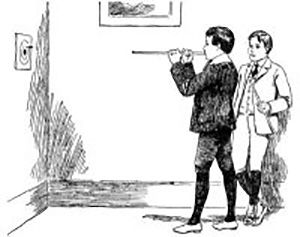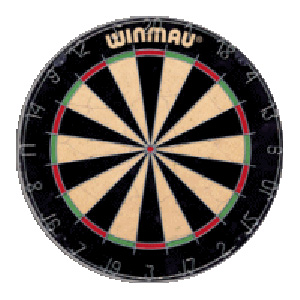Traditionally, dartboards have been constructed of wood, usually elm or poplar. Both are soft woods and are thus easy to cut and shape and to receive the incoming darts. The first dartboards were cut from the end of a tree-trunk and it is believed that the circular pattern of the rings and the way the wood eventually cracks, suggested both the design of the dartboard in terms of its double and treble rings and the separate scoring segments.
The dartboard is a descendent of the archery target (in miniature) made more complicated by the addition of segments and higher scoring rings. A small concentric archery target would not have proved popular for long indoors as players would have enough proven skill to hit the bull’s-eye (100 points) with comparative ease. The game of puff and dart utilised a diamond-shaped target featuring many random numbers, the idea being to score as high a score as possible with three darts. The dartboard was further improved by the addition of individual wires (by skilled wireworkers) to segregate the numbered segments. In later years, these wires would be manufactured as a one-piece unit and eventually became known in the 1970s, especially in the USA and Canada, as ‘the spider.’

The dartboard is a descendent of the archery target (in miniature) made more complicated by the addition of segments and higher scoring rings. A small concentric archery target would not have proved popular for long indoors as players would have enough proven skill to hit the bull’s-eye (100 points) with comparative ease. The game of puff and dart utilised a diamond-shaped target featuring many random numbers, the idea being to score as high a score as possible with three darts. The dartboard was further improved by the addition of individual wires (by skilled wireworkers) to segregate the numbered segments. In later years, these wires would be manufactured as a one-piece unit and eventually became known in the 1970s, especially in the USA and Canada, as ‘the spider.’

Yorkshire or Kent Doubles Board

London Fives or Narrow Fives Board

Manchester Log-end Board
In the early 1930s, as the first darts boom occurred in England, a London-based company named Nodor filed a patent for a new type of dartboard. Made of compressed biscuits of sisal fibre, this dartboard had many advantages over the wooden dartboard. The latter had to be soaked overnight, otherwise it would dry out and crack, damaged darts could pull out pieces of the wooden dartboard when being removed, and those boards had a limited life. The ‘bristle’ dartboard as it was known, was long-lasting, did not need soaking and was more resistant to damage by darts than the elm or poplar board. In addition, with the bristle dartboard, when darts were removed from the board, the sisal fibre closed the hole behind it. With the wooden dartboards this did not happen.

Raw sisal ready to be made into compressed biscuits

Compressed sisal biscuits placed into a forming mould

Cross-section of the board. Wooden
backing glued sisal top

The Nodor Dartboard.
Ready to to be
But the cost of bristle dartboards to ordinary people proved its downfall and although the dartboards sold in sufficient numbers to enable Nodor to continue making them, it would not become standard in the darts world until the 1970s when Dutch elm disease destroyed the supply of wood.
Today, wooden dartboards are rare and bristle boards are seen almost everywhere darts is played.

The evolution of the sisal dartboard has also changed. Dartboard scoring segments are separated using wire fixed to the board usually with staples. This is commonly known as the spider. Round wiring is still the main way for dartboard manufacturers to make up the web, but over the years we have seen further development in this area. Triangle wire and a staple free bulls eye have been introduced to help decrease the dreaded bounce outs.
Further development and the professional players choice has seen the introduction of blade wiring: Strips of metal cut directly into the sisal to separate the scoring areas. This type of construction has removed the need for staples and reduces the wiring thickness which also again reduces bounce outs.
